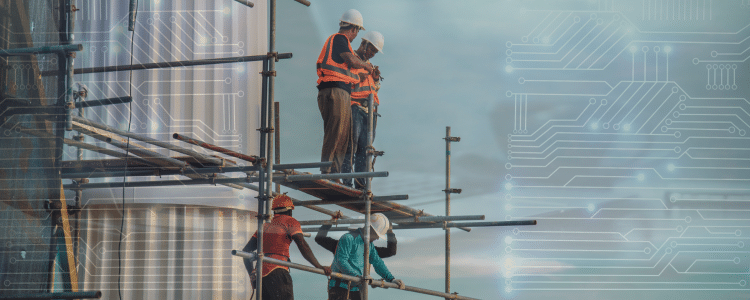As you probably already know, generative AI is a type of artificial intelligence that uses machine learning models to generate new content based on existing data, such as text and images.
While many industries are leveraging generative AI capabilities, today we’re focusing on the use of generative AI in the construction industry. Read on to learn how business leaders are leveraging this technology, and what this might look like for your construction firm.
Generative AI in the Construction Industry: 6 Use Cases
Many ERP systems for construction companies as well as ERP software for architects incorporate generative AI technology. Almost any industry can find a use case for this capability, including the construction sector.
Here are some of the ways these companies are already using this technology to improve their competitive advantage.
1. Optimizing Resource Allocation
Construction schedules, processes, and workflows can be multi-faceted and complex.
Generative AI not only identifies where bottlenecks and inefficiencies are occurring but also recommends process improvements.
Early-adopting construction teams are putting these intelligent suggestions into practice to optimize resource allocation, lower costs, and ensure timely project completion.
The 2024 Top 10 ERP Systems Report
What vendors are considering for your ERP implementation? This list is a helpful starting point.
2. Encouraging Innovation
Construction firms that want to innovate their offerings are finding it easier to do so with generative AI. They can now design new types of buildings, find new ways to improve energy efficiency, and optimize their on-site processes.
3. Sourcing Products and Materials
The sourcing phase can be incredibly time-consuming and tedious for construction teams.
Now, designers and architects are using generative AI to find ideal product matches, greatly reducing the amount of time they spend on this task. They can communicate with the tool to learn about each product’s performance to compare features, benefits, and costs.
4. Improving Safety and Minimizing Risk
Generative AI models can identify both visible and hidden safety hazards lurking at a job site. Companies are using these insights to implement changes and reduce the number of accidents that occur.
When it comes to risk in general, firms are using AI to mitigate construction project risks during the bid phase. Without AI-driven insights, they might place bids based on the approaches they used in the past, which may or may not have been successful.
5. Harnessing Workplace Automation
Studies show that automation and process optimization can help construction companies boost their productivity by up to 60%.
While robotics and autonomous systems are exciting to think about, they’re still not as efficient as they could be. This is where AI comes in.
Construction companies are using generative AI to fine-tune how autonomous systems operate.
First, the AI models identify patterns from construction sites. Then, they adapt their behavior in accordance with what they learn. From assembly and excavation to materials handling, this in-depth knowledge can be applied to a variety of tasks.
6. Predictive Maintenance Support
Imagine how much more efficient construction firms could be if they knew their mission-critical machines were about to break down and they could take action ahead of time.
Generative AI tools are helping them get there.
Once the models gather and analyze historical data from sensors and other sources, they predict when potential issues and breakdowns may occur. This gives companies direct insight into how their equipment are performing and what they need to do to keep it in top shape.
By taking proactive action, they can extend the lifespan of their most valuable assets. This minimizes the risk of system failure, which can improve safety ratings, lower maintenance costs, and boost employee satisfaction.
Challenges to Note
It’s exciting to talk about intelligent automation and how it could change the business realm as we currently know it. However, by adopting this technology, construction firms do assume some degree of risk.
The primary issue centers on reliability. If firms rely mostly on AI-generated design specifications, they must be absolutely sure that those designs are solid. Otherwise, a catastrophic structural failure could occur. If that did happen, it would be difficult to pinpoint which party was at fault.
This may create a need for new legal policies and frameworks regarding generative AI in construction. New industry standards would also apply.
Second, there are concerns about the level of understanding and awareness that construction employees have around generative AI. Companies that dive into this new technological frontier without preparing their employees are putting their businesses at risk. A focus on organizational change management is critical.
Is Generative AI Right for Your Firm?
Now that you know a little more about generative AI in the construction industry, you might be wondering if it’s right for your company.
This technology is still in its early stages, though it’s showing a great deal of promise and potential. Firms can use it to improve resource allocation, lower costs, and reduce risk. At the same time, they can predict and prevent breakdowns, improve safety, and drive innovation.
Our ERP consultants can help you determine if and how an AI-enabled ERP system could benefit your construction company. Contact us below for a free consultation.














